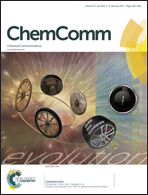Stable, crystalline boron complexes with mono-, di- and trianionic formazanate ligands†
Abstract
Redox-active formazanate ligands are emerging as tunable electron-reservoirs in coordination chemistry. Here we show that boron diphenyl complexes with formazanate ligands, despite their (formal) negative charge, can be further reduced by up to two electrons. A combined crystallographic, spectroscopic and computational study establishes that formazanate ligands are stable in mono-, di- and trianionic form.



 Please wait while we load your content...
Please wait while we load your content...